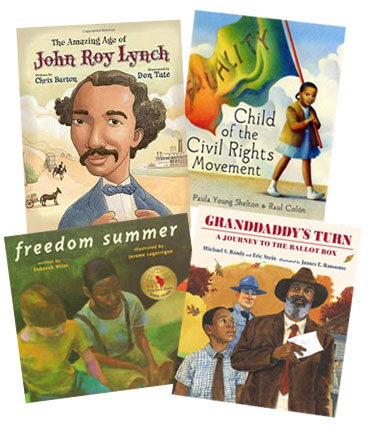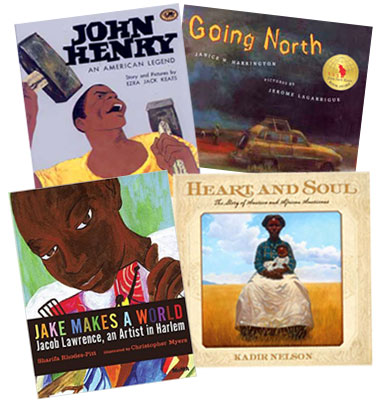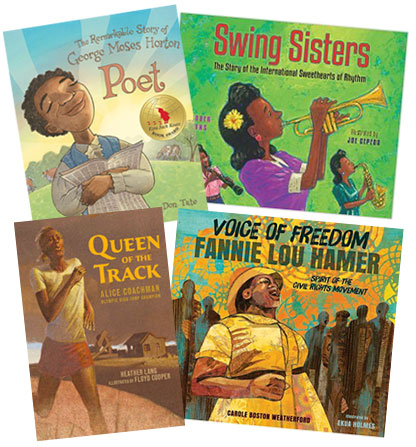Books about African-American heroes teach our children all year round that American history belongs to all of us.
*Winners of the EJK Book Award
 The Amazing Age of John Roy Lynch, by Chris Barton, illustrated by Don Tate (Eerdmans, 2015)
The Amazing Age of John Roy Lynch, by Chris Barton, illustrated by Don Tate (Eerdmans, 2015)
The era of Reconstruction after the Civil War has a controversial history and is not often depicted in children’s books. The story of John Roy Lynch, a former slave who served in Congress from Mississippi, provides a window to this fascinating time.
As Fast As Words Could Fly, by Pamela M. Tuck, illustrated by Eric Velasquez (Lee & Low Books, 2013)
Based on a true story, this book features a 14-year-old boy who supports the civil rights movement by typing his father’s letters of protest against racial injustice. His skill places him in a pivotal role in desegregating a North Carolina high school.
Black Cowboy, Wild Horses: A True Story, by Julius Lester, illustrated by Jerry Pinkney (Dial Books, 1998)
One out of three cowboys was a man of color, and this story is based on the life of a real black cowboy herding wild mustangs on the western plains.
The Case for Loving: The Fight for Interracial Marriage, by Selina Alko, illustrated by Sean Qualls and Selina Alko (Scholastic/Levine, 2015)
This book tells the story of the Lovings, a married couple unable to live in their home state because of its laws against interracial relationships. They fought their case to the Supreme Court, which struck down those laws. The personal side of this legal landmark makes its impact even more powerful.
Child of the Civil Rights Movement, by Paula Young Shelton, illustrated by Raúl Colón (Dragonfly Books, 2013)
The daughter of activist Andrew Young draws an intimate portrait of “Uncle Martin” and the men and women of her “civil rights family” through her childhood memories of the movement and her mother’s macaroni and cheese.
Delivering Justice: W.W. Law and the Fight for Civil Rights, by Jim Haskins, illustrated by Benny Andrews (Candlewick Press, 2005)
The story of the NAACP’s W.W. Law, the postman who led the nonviolent protests that desegregated Savannah, Georgia, in 1961.
Freedom on the Menu: The Greensboro Sit-Ins, by Carole Boston Weatherford, illustrated by Jerome Lagarrigue (Dial Books, 2005)
A young girl witnesses history being made during the 1960 lunch counter sit-ins in Greensboro, North Carolina.
*Freedom Summer, by Deborah Wiles, illustrated by Jerome Lagarrigue (Atheneum, 2001)
How do children make sense of the race hatred stirred up in the South in the 1960s? In this touching story, two best friends, one white and one black, face the problem by staying true to their friendship.
Granddaddy’s Turn, by Michael S. Bandy and Eric Stein, illustrated by James E. Ransome (Candlewick Press, 2015)
A young man recalls his grandfather’s thwarted attempt to vote in the 1960s. It’s a moving reminder of the hard-won battles fought by generations of African-Americans to exercise their rights as full citizens—and that the fight isn’t over.
Harlem’s Little Blackbird: The Story of Florence Mills, by Renée Watson, illustrated by Christian Robinson (Random House, 2012)
This lively book follows the rise of Florence Mills, the beloved musical star of the 1920s who championed black music and performers even as she built her brilliant international career.
*Going North, by Janice Harrington; illustrated by Jerome Lagarrigue (Farrar, Straus and Giroux, 2004)
A poetic, stunningly illustrated story of a family leaving the Jim Crow South of the 1960s and traveling toward the hope of better jobs and a better life in Chicago.
 Heart and Soul: The Story of America and African Americans, by Kadir Nelson (Balzer + Bray, 2011)
Heart and Soul: The Story of America and African Americans, by Kadir Nelson (Balzer + Bray, 2011)
A beautifully illustrated recounting of history by an African-American matriarch, encompassing the life of her African-born grandfather to her vote for the first black President.
It Jes’ Happened: When Bill Traylor Started to Draw, by Don Tate, illustrated by R. Gregory Christie (Lee & Low Books, 2012)
The bittersweet story of Bill Traylor, a sharecropper who was born a slave. He began to draw at the age of 85, and today he is considered one of the foremost American folk artists.
Jake Makes a World: Jacob Lawrence, a Young Artist in Harlem, by Sharifa Rhodes-Pitts, illustrated by Christopher Myers (Museum of Modern Art, 2015)
The year was 1930, and young Jacob Lawrence had just moved to New York to live with his mother. We follow the 13-year-old as he explores his new world, seeing it through the eyes of the artist he would become.
John Henry: An American Legend, by Ezra Jack Keats (Pantheon, 1965)
The mythic figure of John Henry is believed by many to have actually lived. In Keats’s powerfully illustrated rendition, the famed “steel-drivin’ man” pits himself against the machine that is threatening the jobs of his fellow railroad men.
Lillian’s Right to Vote: A Celebration of the Voting Rights Act of 1965, by Jonah Winter, illustrated by Shane W. Evans (Schwartz & Wade, 2015)
As an old woman makes her way up a steep hill to her polling place, she finds the strength to keep going by envisioning the events she and her forebears lived through that led to the right to vote. This book will start important class discussions in grades 4 to 7.
March On!: The Day My Brother Martin Changed the World, by Christine King Farris, illustrated by London Ladd (Scholastic, 2008)
The older sister of Martin Luther King, Jr., offers a unique perspective on the 1963 March on Washington as she remembers her brother as a boy and as a leader.
Martin & Mahalia: His Words, Her Song, by Tonya Cherie Hegamin, illustrated by Cozbi Cabrera (Houghton Mifflin, 2009)
by Andrea Davis Pinkney, illustrated by Brian Pinkney (Little, Brown, 2013)
The legacies of Dr. King and the Queen of Gospel Mahalia Jackson are intertwined, as theirs were the epic voices of the 1963 March on Washington. The story of their lives and friendship also shows how the arts inspire and narrate social change.
*Most Loved in All the World, by Tonya Cherie Hegamin, illustrated by Cozbi Cabrera (Houghton Mifflin, 2009)
A deeply moving story of the Underground Railroad, from the perspective of a young girl whose mother sends her northward with a quilt to guide her toward Freedom and to remind her that she is the “most loved in all the world.”
 *Poet: The Remarkable Story of George Moses Horton, by Don Tate (Peachtree Publishers, 2015)
*Poet: The Remarkable Story of George Moses Horton, by Don Tate (Peachtree Publishers, 2015)
This biography introduces us to the first black writer published in the South as an individual whose talent and commitment could not be crushed. His life and his poems reveal the strange contradictions of slavery. The book earned its author the 2016 EJK Book Award for New Writer.
Queen of the Track: Alice Coachman, Olympic High-Jump Champion, by Heather Lang, illustrated by Floyd Cooper (Boyds Mills Press, 2012)
The inspiring journey of this natural athlete from the rural South to the 1948 London Olympics, where she was the first African-American woman to win the gold.
The School Is Not White!: A True Story of the Civil Rights Movement, by Doreen Rappaport, illustrated by Curtis James (StarWalk Kids Media, 2014)
How the Carter family desegregated a Mississippi high school in 1965: with faith, determination and the courage to show up every single day.
Swing Sisters: The Story of the International Sweethearts of Rhythm, by Karen Deans, illustrated by Joe Cepeda (Holiday House, 2015)
The first integrated “all-girl” band toured America and postwar Europe playing big-band jazz in the 1940s, a time when women musicians weren’t taken seriously and blacks and whites in the South were segregated by law. The Sweethearts’ story, with its joys and hardships, is one of accomplishment, friendship and prejudice that needs to be known.
Voice of Freedom: Fannie Lou Hamer, Spirit of the Civil Rights Movement by Carole Boston Weatherford, illustrated by Ekua Holmes (Candlewick Press, 2015)
Fannie Lou Hamer became a hero during Freedom Summer, 1964. The former sharecropper turned activist registered African-Americans to vote and was beaten for it. Afterward, she led the Mississippi Freedom Democratic Party to break the all-white, anti-civil rights hold on southern politics. Her story is told in first-person verse, as though she is sharing her memories with a new generation.
We Are the Ship: The Story of Negro League Baseball, by Kadir Nelson (Jump at the Sun/Hyperion, 2008)
This gorgeous book tells the story of the Negro Leagues, which rivaled the best white teams, and how Major League Baseball was integrated.
White Socks Only, by Evelyn Coleman, illustrated by Tyrone Geter (Albert Whitman & Company, 1996)
A heartwarming story of a young girl who innocently defies the “whites-only” rule, and with the help of her neighbors, succeeds in breaking it for good.
